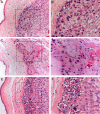The Human Ureaplasma Species as Causative Agents of Chorioamnionitis
- PMID: 27974410
- PMCID: PMC5217797
- DOI: 10.1128/CMR.00091-16
The Human Ureaplasma Species as Causative Agents of Chorioamnionitis
Abstract
The human Ureaplasma species are the most frequently isolated microorganisms from the amniotic fluid and placentae of women who deliver preterm and are also associated with spontaneous abortions or miscarriages, neonatal respiratory diseases, and chorioamnionitis. Despite the fact that these microorganisms have been habitually found within placentae of pregnancies with chorioamnionitis, the role of Ureaplasma species as a causative agent has not been satisfactorily explained. There is also controversy surrounding their role in disease, particularly as not all women infected with Ureaplasma spp. develop chorioamnionitis. In this review, we provide evidence that Ureaplasma spp. are associated with diseases of pregnancy and discuss recent findings which demonstrate that Ureaplasma spp. are associated with chorioamnionitis, regardless of gestational age at the time of delivery. Here, we also discuss the proposed major virulence factors of Ureaplasma spp., with a focus on the multiple-banded antigen (MBA), which may facilitate modulation/alteration of the host immune response and potentially explain why only subpopulations of infected women experience adverse pregnancy outcomes. The information presented within this review confirms that Ureaplasma spp. are not simply "innocent bystanders" in disease and highlights that these microorganisms are an often underestimated pathogen of pregnancy.
Keywords: Ureaplasma; amniotic fluid; chorioamnionitis; multiple-banded antigen; neonate/fetus; pregnancy; virulence factors.
Copyright © 2016 American Society for Microbiology.
Figures






References
-
- Romero R, Miranda J, Kusanovic JP, Chaiworapongsa T, Chaemsaithong P, Martinez A, Gotsch F, Dong Z, Ahmed AI, Shaman M, Lannaman K, Yoon BH, Hassan SS, Kim CJ, Korzeniewski SJ, Yeo L, Kim YM. 2015. Clinical chorioamnionitis at term I: microbiology of the amniotic cavity using cultivation and molecular techniques. J Perinat Med 43:19–36. doi: 10.1515/jpm-2014-0249. - DOI - PMC - PubMed
-
- Romero R, Chaemsaithong P, Docheva N, Korzeniewski SJ, Kusanovic JP, Yoon BH, Kim JS, Chaiyasit N, Ahmed AI, Qureshi F, Jacques SM, Kim CJ, Hassan SS, Chaiworapongsa T, Yeo L, Kim YM. 2016. Clinical chorioamnionitis at term VI: acute chorioamnionitis and funisitis according to the presence or absence of microorganisms and inflammation in the amniotic cavity. J Perinat Med 44:33–51. doi: 10.1515/jpm-2015-0119. - DOI - PMC - PubMed
Publication types
MeSH terms
Substances
LinkOut - more resources
Full Text Sources
Other Literature Sources
Medical
Miscellaneous

